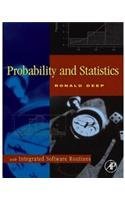Full Download Probability And Statistics: With Integrated Software Routines (With Cd Rom) - Ronald Deep file in PDF
Related searches:
4250 1687 1044 4889 3580 1231 691 3367 2596 2781 3848 4800 3070 4888 2538 1440 649 2629 3853 409 1694 2974 749 2128 4319 4356 3970 134 1777 3215 1839 4147 1038 2005 333 3870
Probability and statistics are two branches of mathematics that are highly related, so they are often studied together since statistical analysis often involve the use of probability distributions. There are also many aspects of probability theory that involve topics that are almost entirely mathematical.
Ideas formulated in terms of statistics and probability are uniquely portable across applied modeling and data-driven disciplines.
Find tables, articles and data that describe and measure elements of the united states tax system. An official website of the united states government help us to evaluate the information and products we provid.
See how to measure this asymmetry with a statistic called skewness. Some distributions of data, such as the bell curve or normal distribution, are symmetric.
Jul 22, 2015 probability and statistics with r, second edition shows how to solve various statistical problems using both parametric and nonparametric.
Learn statistics and probability for free—everything you'd want to know about descriptive and inferential statistics. If you're seeing this message, it means we're having trouble loading external resources on our website.
A developed, complete treatment of undergraduate probability and statistics by a very well known author. The approach develops a unified theory presented with clarity and economy.
This course provides an elementary introduction to probability and statistics with applications. Topics include: basic combinatorics, random variables, probability distributions, bayesian inference, hypothesis testing, confidence intervals, and linear regression.
To learn more about a topic listed below, click the topic name to go to the corresponding mathworld classroom page.
What you'll learn understand the basics of probability be able to implement basic statistics understand how to use various statistical distributions apply.
The fundamentals of probability-based statistics with a focus on data-based problem solving.
The student will identify properties of a normal distribution and apply the normal distribution to determine probabilities.
Probability and statistics statistics and probability are sections of mathematics that deal with data collection and analysis. Probability is the study of chance and is a very fundamental subject that we apply in everyday living, while statistics is more concerned with how we handle data using different analysis techniques and collection methods.
Statistics is the collection, tabulation, and systematic classification of data, especially for use in predicting probable future trends. Crude ideas of probability and statistics likely evolved with the earliest humans, helping them decide where to go in search of food, shelter, and safety.
Two examples of probability and statistics problems include finding the probability of outcomes from a single dice roll and the mean of outcomes from a ser two examples of probability and statistics problems include finding the probability.
Probability and statistics are fascinating subjects on the interface between mathematics and applied sciences that help us understand and solve practical.
Probability and statistics, the branches of mathematics concerned with the laws governing random events, including the collection, analysis, interpretation, and display of numerical data. Probability has its origin in the study of gambling and insurance in the 17th century, and it is now an indispensable tool of both social and natural sciences.
Addition rules in probability provide a way to calculate the probability of the union of two events. These rules provide us with a way to calculate the probability of the event a or b, provided.
Probability vs statistics probability theory is a branch of mathematics c o ncerned with probability. Probability is a numerical description of the likelihood of an event. A lot of times by saying probability, we refer to probability theory and not just the number.
In the world of statistics, there are two categories you should know. Descriptive statistics and inferential statistics are both important.
It deals with the chance (the likelihood) of an event occurring.
The journal publishes papers in applied probability, applied statistics, computational statistics, mathematical statistics, probability theory and stochastic processes.
Probability and statistics courses teach skills in understanding whether data is meaningful, including optimization, inference, testing, and other methods for analyzing patterns in data and using them to predict, understand, and improve results.
The normal distribution is nothing but a probability distribution. Thus the relationship between probability and statistics cuts both ways - statistical analysis makes use of probability and probability calculation makes use of statistical analysis. In general, we are interested to know, what is the chance of an event occurring.
Apr 24, 2020 this article on statistics and probability, will help you understand the math behind the most complex algorithms and technologies.


Post Your Comments: